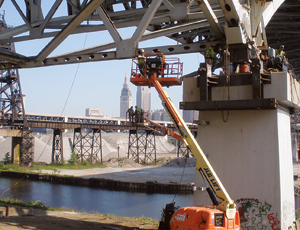The one kind of surprise you might want if you were moving more than 500 ft of bridge section would be to have things slip and slide along even more smoothly than expected. That is what happened over Memorial Day weekend in Cleveland as crews moved the Innerbelt Bridge 4 in. to open up an expansion joint.
Using a painstakingly coordinated cast of hydraulic rams and jacks, crews pushed about 10 million lb of bridge section westward. The feat frees up an expansion joint on the west section, previously blocked by the eastward shift of the truss due to a slope’s slow slide on the western end of the Cuyahoga River.
The 50-year-old 5,078-ft-long crossing consists of multiple cantilevered steel- truss spans and carries Interstate 90 over the Cuyahoga River into downtown Cleveland. It is similar in design to the I-35W bridge in Minneapolis that collapsed.
Pier 1 at the west end of the bridge sits on friction piles in a slope with slip plains. “The slope wants to move into the river,” says Tom Hyland, area engineer for District 12 of the Ohio Dept. of Transportation. “The bridge moves with the slope. That is what closed up the expansion joint.” In 1999 ODOT installed a tieback system with drilled shafts 150 ft deep in the slope to mitigate movement.
Working under a $892,000 contract, Ruhlin Co., Sharon Center, Ohio, and a cast of 20 ironworkers gathered early May 23 to close the bridge to traffic. The first step was to disconnect the anchor bolts from the bolster—the fixed piece that connects the pier cap to the superstructure—jack the truss and bolster up 4 in., then install an 80-in. x 74-in. composite steel plate underneath the bolster, says Chuck Fisher, Ruhlin structural group general manager. The 1.5-in.-thick bottom plate had a 1⁄8-in. layer of Teflon attached, and the ½-in.-thick top plate was topped with 1⁄8-in. of stainless steel. Crews then lowered the truss and bolster back down and prepared to push the 525-ft-long section westward with 26 sets of hydraulic jacks located strategically along the piers, chords and deck, with a total of 4,000 tons of force.
“We had to monitor the pressure at each pump,” Fisher says. “We had four steps to follow to gradually bring up pressure on the bridge.” Consulting engineer Richland Engineering Ltd., Mansfield, Ohio, had calculated the bridge would begin moving near the end of step two, but “the bridge started to move almost immediately,” with less than 300 tons of force applied, he says. “We stopped because Richland wanted to go through more calculations.”
Based on a similar realignment 10 years ago, “we thought we would have more rust and friction to overcome,” Hyland says. “But it moved better than we thought. The plates worked very well. We are happy we did not have to get up to the pressures we had calculated.”
With crew members in constant communication, the bridge push commenced for 2 in., then only the rams on the bottom chord were used, says Fisher. The moved section includes a truss over the west slope and 300 ft of a truss over the river. That latter section did not travel as far as the western-most section, so the rams on its chords “gave it a nudge to catch up,” says Hyland. “Once we started applying force just to the bottom chord...there was quite a bit of noise—loud banging and shaking,” adds Fisher.
Ruhlin had to reopen the bridge in time for downtown holiday events on Saturday night. “To close the bridge during a weekend with so many events was the most challenging thing about scheduling the project,” says ODOT spokeswoman Jocelynn Clemings. The following weekend would have been even more difficult, because the Yankees were in town playing the Cleveland Indians, adds Hyland.
Steel braces locked the bridge in place for Saturday. On Sunday, the crews jacked up the bolster again to remove the plate, lowered it and installed new anchor bolts. By June’s end, Ruhlin will have removed all temporary steel and cleared the site.
The Federal Highway Administration mandated the realignment occur before May 31, due to concerns about thermal expansion. “We put plans together in February and got them out on the street late March,” says Hyland. “A traditional project—we are talking 16 weeks of advertising, getting signatures—the review process would be six to eight weeks.”
Bidders had a week and half, says Fisher. Ruhlin left $250,000 on the table, thanks in part to consultation with ironworkers, he says. “We sat for six hours and talked the job through...then determined our final price.” In 30 days, ironworkers fabricated and installed 90,000 lb of temporary steel needed to support the jacking, notes Hyland. Work is not over. “We still have an additional $10-million steel repair job coming this summer,” he says.
Clemings says ODOT received $85 million in economic stimulus funding under the American Recovery and Reinvestment Act, which brings ODOT’s total for replacing the westbound structure to $400 million. “Once that structure is completed, we would like to build a new eastbound structure,” says Hyland.


Post a comment to this article
Report Abusive Comment